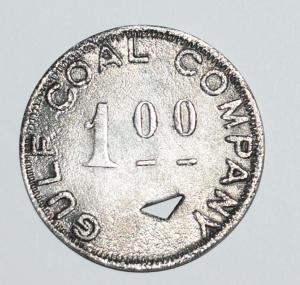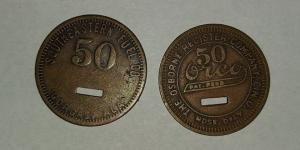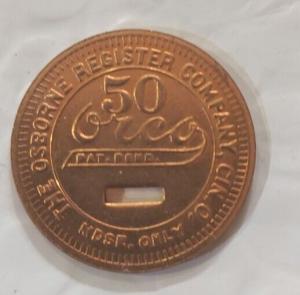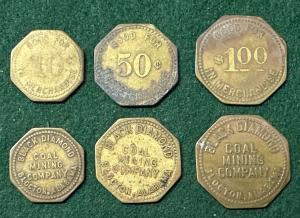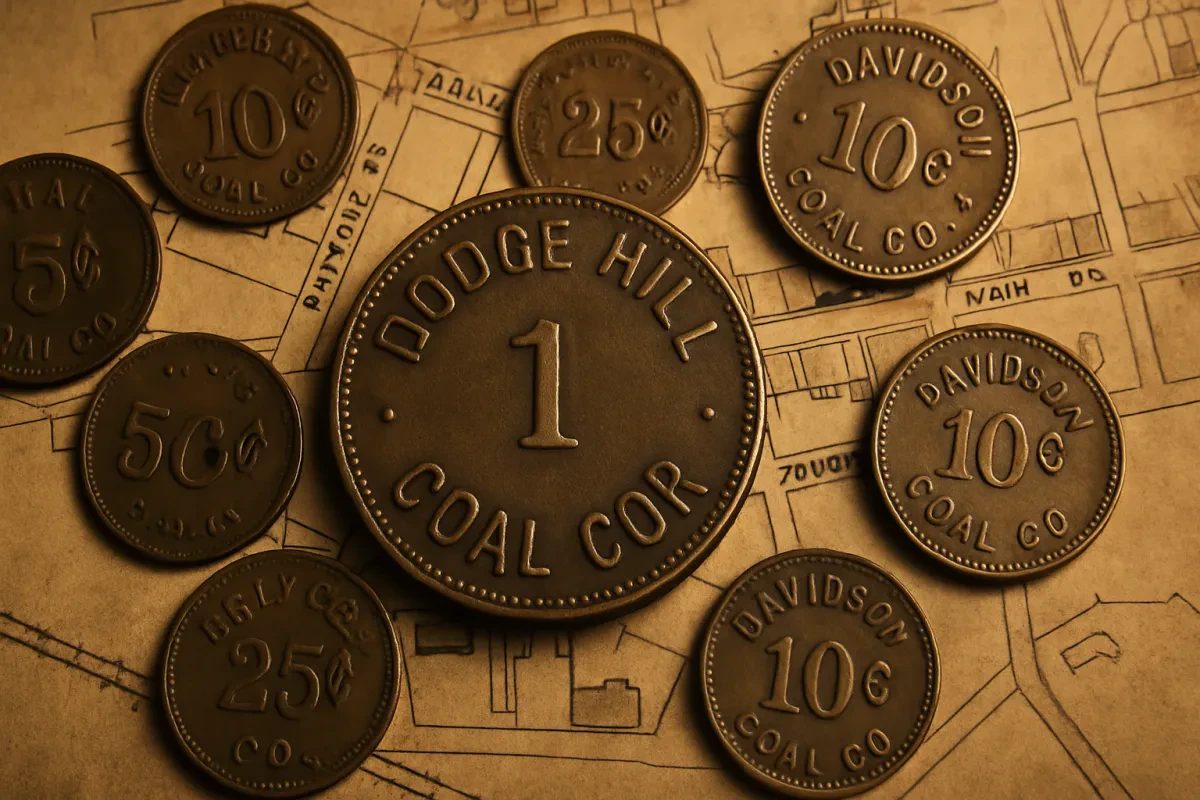Coal company scrip was a private currency that defined daily life in coal towns across America from the late 1800s through much of the 20th century. Instead of paying wages entirely in U.S. dollars, many coal operators advanced “store credit” in the form of metal tokens or paper chits redeemable only at the company’s own store, doctor, or boarding house. In remote one-industry towns, this created a closed economy where miners and their families depended entirely on their employer.
What Was Coal Company Scrip?
Company scrip was a substitute for cash. It usually appeared as round brass, zinc, or aluminum tokens stamped with the coal company’s name, denomination, and sometimes the specific mine or camp. These tokens had value only inside the company’s ecosystem—most often the company store—creating an economy controlled by the employer.
Coal towns were frequently built and owned by the coal company itself. With housing, schools, churches, and stores all tied to the company, miners had few choices but to spend their scrip where their employer dictated. Company stores often charged higher prices than nearby towns, trapping many families in debt that carried over each payday. This system inspired the famous line from Merle Travis’s song “Sixteen Tons”—“I owe my soul to the company store.”
Why Did Coal Companies Use Scrip?
Coal companies claimed scrip was necessary to keep operations running smoothly in isolated locations. It reduced the need to transport large amounts of cash to remote mining camps and allowed operators to extend credit between paydays. For the company, it also provided powerful control: by owning the store, housing, and local economy, management could ensure workers’ dependence and loyalty. It also made it easier to deduct debts and purchases directly from miners’ wages.
Scrip systems gave companies leverage during labor strikes and negotiations. When workers relied on scrip for food and essentials, walking off the job meant losing not just income—but access to basic necessities.
The Decline of Scrip
By the early 20th century, growing public criticism and new labor laws began challenging the legality of company scrip. Federal and state reforms, such as the Fair Labor Standards Act of 1938, required wages to be paid in legal U.S. currency. Improved transportation, the rise of mail-order catalogs like Sears and Montgomery Ward, and increased union power gradually eroded the company store’s monopoly.
Even so, some coal companies continued issuing scrip well into the 1960s. One of the last major users was the Stearns Coal & Lumber Company in Kentucky, which continued issuing scrip until 1964.
Major Coal Companies That Used Scrip
While thousands of coal operators issued their own tokens, several well-known companies became synonymous with the scrip era.
Consolidation Coal Company (later CONSOL Energy)
Founded in 1860, Consolidation Coal became one of America’s largest producers of bituminous coal. The company built towns like Jenkins, Kentucky, where scrip circulated widely. Tokens in denominations from 1¢ to $1 were common, and miners could use them for everything from groceries to medicine. Because of Consolidation’s size and influence, its labor and wage systems shaped much of the Appalachian coal industry.
Island Creek Coal Company
Operating throughout southern West Virginia, Island Creek was one of the region’s most prominent companies. Its camps, including Taplin and Omar, issued $1 tokens and even specialized “powder checks” for purchasing explosives. Island Creek’s scrip system shows how deeply integrated company credit was in both personal and professional aspects of a miner’s life.
Jamison Coal & Coke Company
Based in Pennsylvania and West Virginia, Jamison Coal & Coke Company used scrip for both store purchases and mine supplies. Tokens labeled “powder check” or “lamp check” were used to track distributed materials. This company’s records reveal how scrip doubled as a tool of workplace management as much as an economic medium.
Pocahontas Fuel and Pocahontas Consolidated Collieries
These companies operated in the rich Pocahontas coalfields of southwest Virginia and southern West Virginia. Payroll ledgers and accounting records from the era show deductions for store purchases, medical fees, and rent—all tied to scrip use. In these camps, the company effectively managed every financial aspect of a miner’s life.
Tennessee Coal, Iron & Railroad Company (TCI)
Before becoming part of U.S. Steel, TCI was one of the South’s largest industrial operations, controlling coal and iron mines near Birmingham, Alabama. Company tokens from Ensley and nearby camps demonstrate that even large industrial conglomerates relied on scrip to run their towns and stores efficiently.
Colorado Fuel & Iron Company (CF&I)
CF&I dominated the coalfields of southern Colorado, operating massive company towns and maintaining strict control over workers’ lives. The company’s dominance, and the conditions created by its scrip and store systems, were key factors in the labor conflicts that led to the infamous 1914 Ludlow Massacre. CF&I’s story shows how scrip was deeply connected to the larger struggles between labor and management in industrial America.
Stearns Coal & Lumber Company
Operating in Kentucky and Tennessee, Stearns Coal & Lumber is famous for being one of the last companies to use scrip extensively. In 1939 alone, the company issued nearly $800,000 worth of tokens—less than half of which were redeemed at its stores. Stearns continued the practice until 1964, marking the end of the scrip era in American coal mining.
How the Scrip System Worked
-
Denominations and Materials: Most scrip came in metal form—brass, aluminum, or zinc—and ranged from 1¢ to $1. Each token carried the company’s name and often the town, preventing use outside the system.
-
Credit and Deductions: Miners could draw scrip between paydays to buy necessities. On payday, the company deducted these purchases, along with rent, medical costs, and insurance, directly from wages.
-
Restricted Tokens: Some scrip was used for specific purposes like “powder checks” for explosives or tools, adding an extra layer of control over miners’ work.
-
Private Mints: Specialized private mints across the country produced millions of these tokens, each unique to its company and region.
Labor Conflicts and Reform
Company scrip played a major role in labor movements across Appalachia, Pennsylvania, and the West. Miners often fought not just for higher wages but for the right to be paid in legal tender. The eventual banning of mandatory scrip systems marked a key victory for unions and workers’ rights advocates.
Even after scrip was officially outlawed, many miners continued to shop at company stores out of habit or necessity. By the 1960s, as highways improved and independent towns grew nearby, the system finally faded into history.
Legacy and Collecting Coal Company Scrip
Today, coal company scrip is a prized collectible and a fascinating historical artifact. Each token tells a story of the community it came from—its company, its camp, and the people who relied on it. Museums and collectors preserve thousands of examples, offering tangible evidence of a time when a miner’s paycheck was controlled down to the penny by the same company that signed it.
These tokens represent more than just old metal—they are a window into an era when coal fueled the nation and shaped the working-class experience of millions of Americans.
Final Thoughts
Coal company scrip was more than a form of payment—it was a system of control, loyalty, and survival. For decades, it governed life in company towns, tying families’ livelihoods to a single employer. While the system eventually faded, its influence lingers in the culture, history, and collective memory of coal country.
From the mountain towns of Appalachia to the industrial mines of the South and West, coal company scrip remains a powerful symbol of America’s industrial past and the resilience of its working class.
